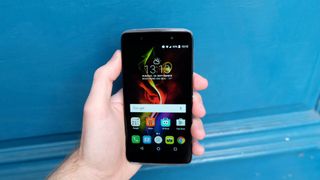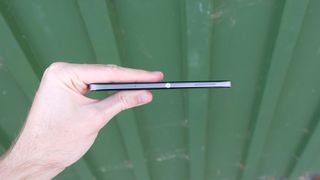TechRadar Verdict
Alcatel has packed some eye-catching features into this highly affordable phone, including a VR headset, a metal-and-glass design, and stereo speakers. But a subpar VR experience and poor battery life have us questioning its priorities.
Pros
- +
Stereo speakers
- +
Decent screen
- +
Competent camera
Cons
- -
Bad battery life
- -
Phone isn't up to rendering VR
- -
Mediocre performance
Why you can trust TechRadar
You can scarcely swing a phone charger these days without hitting an accomplished Android phone for around the $250/£200/AU$330 mark, and here’s another in the Alcatel Idol 4. As that suggests, though, it’s getting increasingly difficult to stand out from the highly competent crowd.
Some manufacturers look to squeeze in a higher-end component or two to make their phone stand out, while others focus on a more premium design. Alcatel, for its part, has decided to throw in a couple of features that tread the narrow line between showstopper and gimmick.
While the initial RRP for the Alcatel Idol 4 is £230 (around $280/AU$370), at the time of writing this review it was possible to pick one up for roughly £190 (around $245/AU$320).
That’s not a bad price for a capable lower-mid-range Android handset such as this, but it’s not a brilliant one either. After all, you can pick up the similarly specced Motorola Moto G4 for £170/$200/AU$330.

However, this price is made more impressive when you consider that the Alcatel Idol 4 comes with a VR headset as standard. It even forms part of the box, so you know this isn’t some temporary give-away à la the Samsung Galaxy S7 and the Gear VR.
Stir in some bold audio claims and an unusual multi-function hot key, and we undoubtedly have one of the more interesting entry-level Android phones we’ve tested in 2016. But does it all hang together?
Future's made of virtual reality
- Customizable Boom key
- Decent VR headset, but the screen isn't good enough
- Impressive speakers
If you’ll pardon that Jamiroquai reference (tough ask, we know), VR is without a doubt the Alcatel Idol 4’s headline feature. The manufacturer hasn’t just thrown a headset in - it’s built the very packaging for the phone out of it.
We’re essentially looking at a competently made, altogether more permanent take on Google Cardboard. The headset is made out of reasonably lightweight plastic, and there’s a headstrap and generous sponge padding around your eyes and nose that both makes the headset comfortable to wear for longer periods and keeps out light.

The Idol 4 hooks into a simple but sturdy clip system, and there’s space for earphones to be used - which really is recommended with any such VR experience.
There are a couple of slightly cheap-feeling, touch-sensitive plastic buttons on the bottom edge of the headset that we weren’t too sure about. We found that we would often mistakenly press one of these in the process of slipping the headset on, so we had to deliberately modify our natural process.
Still, the VR headset itself is an effective piece of kit. What isn’t up to VR scratch is the Idol 4. It’s not the lower-end CPU that does it - though we can’t imagine the Snapdragon 617 being ready for the next wave of advanced VR games - but rather the phone’s display. At 1080p, all of the VR experiences we tried were blurry and ugly.

VR is arguably the one thing that justifies QHD and even 4K resolutions in mobile displays. Using the Idol 4 for VR will have you pining for that Samsung Galaxy S7 with the Gear VR - if such casual VR is your thing, of course.
Tying into this idea that the Idol 4 is a multimedia-focused device, it has an unusually accomplished speaker set-up. Not only does it have stereo speakers - which is still relatively unusual for a high-end phone, let alone an affordable one - but it also has a second pair on the back.

This means that even if your phone is face down, you’ll be able to hear your music loud and clear. You won’t get a lot of bass from that sound, but there’s definite stereo separation in there.
You also get a set of standard JBL earbuds bundled in. They’re not great, but they’re better than most bog standard efforts.
Another unusual feature of the Alcatel Idol 4 is its dedicated ‘Boom key’. This is an additional context-sensitive button found mid-way up the right hand edge of the phone.
It can be customized to fulfil a number of roles. By default, it will kick off a little weather animation on the home screen, while a double tap while the phone is asleep will take an instant snapshot with the main camera. Holding will take a burst shot.

You can also set the Boom key to launch the camera app - though only when the screen is on, unfortunately. It’s also possible to assign a specific app to it, which could come in useful if you’re a heavy Facebook or Spotify user.
We often wonder why more Android manufacturers don’t experiment with such specialist shortcut keys - particularly with the increasing scarcity of physical home buttons. Alcatel’s efforts here aren’t fully formed, but they’re most welcome.
Design and display
- Strong metal and glass design
- Display is bright and well proportioned
We can’t say that we found the Alcatel Idol 4 attractive, as such, but its metal and glass design is streets ahead of what you would have expected of a $250/£200/AU$300 phone just 18 months ago.
Its look and feel benefit greatly from a metal rim, which gradually thickens towards the top and bottom edges. Those edges also stick up above the glass front and back (yes, it’s a fingerprint magnet) by a good few millimetres, allowing for the four speakers to face directly out towards you.
This latter feature isn’t particularly appealing from an aesthetic standpoint, but it’s certainly functional. It also helps the phone stand out from all those iPhone and Galaxy wannabes.
One other thing to note is that the presence of the unorthodox Boom key has forced a bit of a reshuffle on the button front. The volume key feels a lot higher than normal, near the top of the right hand edge.

The power key, meanwhile, has been forced over to the left hand edge. Both buttons fall naturally under your thumb and forefinger, but it will still take a while to adjust to their placement.
At 7.1mm thick and 135g, the Idol 4 is in that sweet zone for a smartphone - it’s just thick and heavy enough to sit unobtrusively in a pocket whilst remaining comfortable to hold. It also makes the phone significantly thinner and lighter than the Moto G4 at 9.8mm and 155g.
One major reason for these smaller dimensions is that the Idol 4 has a relatively petite display by modern Android standards at 5.2 inches. 5.5 inches almost seems to be the new normal for phones, though around 5.2 inches isn’t uncommon where there are two sizes of a phone on offer (as there is here, thanks to the Alcatel Idol 4S).

The screen isn’t lacking in quality, either, with 1080p proving plenty sharp enough for a phone of this size - except when it comes to VR, of course. We were also impressed with the brightness of the display, which is often something that suffers on cheaper phones, whilst the color temperature is nice and cool.
The colors don’t pop as much as they do on a decent mid-range phone, but they’re just fine for something of this price.
First reviewed: October 2016

